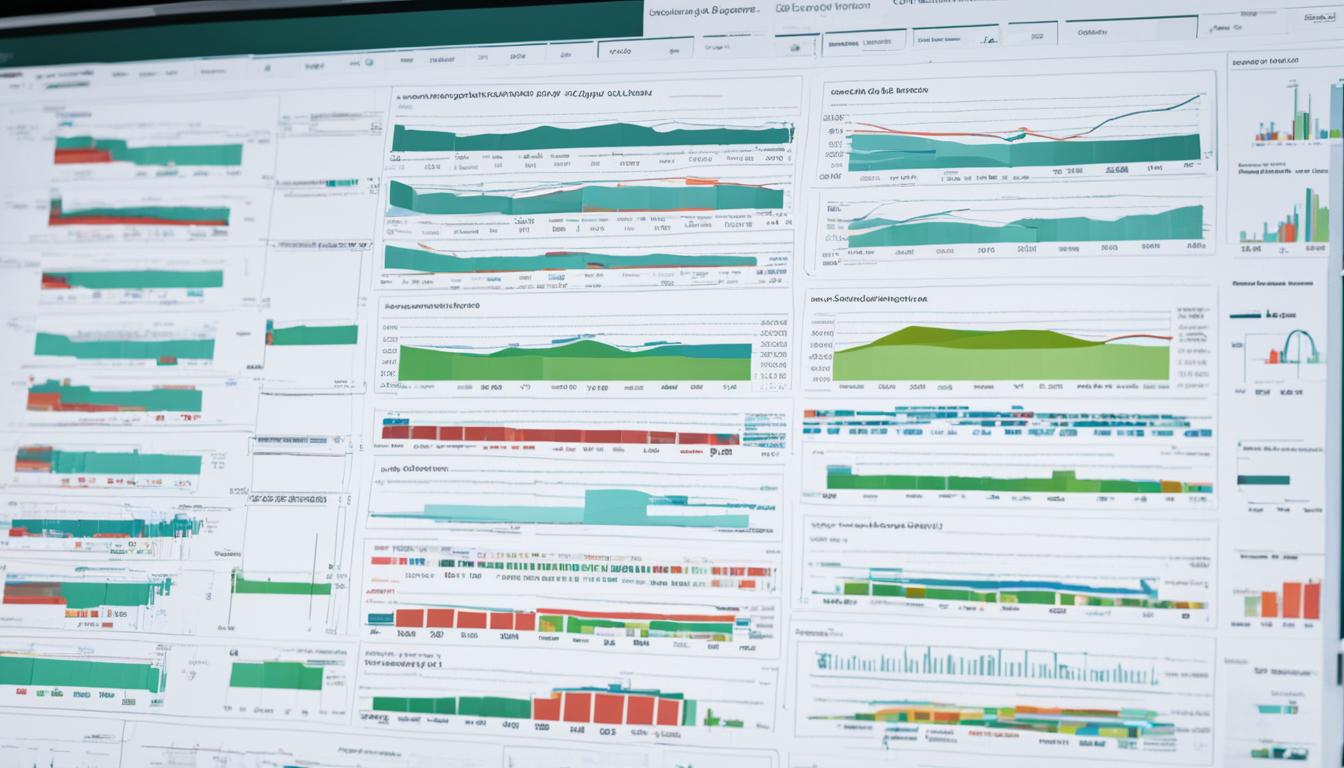Data Science in Finance: Trends & Insights
Data science is revolutionizing the field of finance, bringing new opportunities and transforming traditional practices. With the increasing availability of financial data and advancements in technology, data science has become a vital tool for financial institutions.
Financial data analysis, machine learning in finance, predictive models in finance, and data-driven decision making are some of the key areas where data science is making a significant impact. By leveraging artificial intelligence and quantitative finance techniques, financial institutions are gaining valuable insights and making data-driven decisions.
One area where data science has had a transformative effect is algorithmic trading. By using complex algorithms and historical market data, financial institutions can automate trading processes and make informed investment decisions. This not only enhances efficiency but also mitigates risks and improves overall portfolio performance.
Risk management in finance has also been revolutionized by data science. Through the analysis of vast amounts of financial data, predictive models are used to identify and assess potential risks, enabling timely intervention and proactive risk mitigation strategies.
The adoption of financial technology, or fintech, has further accelerated the use of data science in finance. Fintech startups are using innovative data-driven approaches to create personalized financial solutions, such as automated budgeting tools and robo-advisors, catering to the evolving needs of consumers.
Overall, data science in finance is driving innovation, enabling financial institutions to optimize their operations, provide personalized services, and make data-driven decisions that have a profound impact on their bottom line.
Throughout this article, we will delve deeper into the latest trends and insights in data science in finance, exploring how it is transforming the industry and creating new possibilities.
Key Takeaways:
- Data science is playing a transformative role in the field of finance.
- Machine learning and predictive models are enhancing risk management and decision-making processes.
- Algorithmic trading is automating investment decisions and improving portfolio performance.
- Financial technology startups are leveraging data science to create personalized financial solutions.
- Data-driven insights are driving innovation and transforming traditional practices in finance.
Increased Adoption of Cloud-Based Solutions
Banks in the finance industry are witnessing an increased adoption of cloud-based solutions to revolutionize their data management practices. With the ever-growing volume of financial data, storing, processing, and analyzing it has become a significant challenge for traditional on-premises infrastructure. Cloud technology offers a scalable and cost-effective alternative that enables banks to leverage the power of data to gain valuable insights, reduce operational costs, and improve decision-making processes.
One of the key advantages of cloud-based solutions is their immense storage capacity, allowing banks to store and access vast amounts of financial data securely. Cloud platforms provide reliable data storage options, ensuring that critical information is readily available whenever it is needed. By utilizing cloud-based storage solutions, financial institutions can eliminate the constraints of physical infrastructure and avoid the risk of data loss or theft.
Cloud technology also facilitates efficient data processing and analysis. With cloud-based solutions, banks can leverage powerful processing capabilities to handle complex calculations, statistical models, and predictive algorithms. This enables them to extract meaningful insights from financial data and make data-driven decisions in a timely manner.
In addition to scalability and data processing capabilities, cloud-based solutions provide advanced analytics tools that empower banks to perform in-depth data analysis. By leveraging these tools, financial institutions can uncover hidden patterns, trends, and correlations within their data, enabling them to make more accurate predictions and informed business decisions.
Another significant benefit of adopting cloud-based solutions is the scalability they offer. Traditional infrastructure often poses challenges in handling sudden increases in data volumes or processing requirements. However, with cloud technology, banks can quickly scale their resources up or down as needed, ensuring that their data processing and storage capacities align with their business demands.
“Cloud technology offers improved scalability, reduced costs, and the ability to gain valuable insights into customer behavior and market trends.”
Furthermore, cloud-based solutions enable financial institutions to significantly reduce costs associated with data management. Cloud platforms eliminate or minimize the need for investing in costly hardware and software infrastructure, as well as the ongoing maintenance and upgrades that come with it. Instead, banks can leverage cloud services provided by trusted and specialized vendors, reducing their overall IT expenses.
Moreover, cloud technology provides enhanced security measures, protecting financial institutions’ data from cyber threats. Cloud service providers employ advanced security protocols, encryption techniques, and access controls to ensure the confidentiality, integrity, and availability of data. This allows banks to focus on their core business while trusting in the robust security measures provided by the cloud.
The increased adoption of cloud-based solutions in the finance industry is transforming the way banks store, process, and analyze their data. By embracing cloud technology, financial institutions can overcome the limitations of traditional infrastructure, gain valuable insights, achieve scalability, reduce costs, and enhance overall operational efficiency.
The Use of Natural Language Processing (NLP) and Chatbots
Natural Language Processing (NLP) and chatbots have become valuable tools in the finance industry, revolutionizing customer service and automating repetitive tasks. By harnessing the power of NLP, banks can provide efficient and personalized solutions to their customers, while chatbots enable 24/7 support and seamless interactions.
With the help of NLP, financial institutions can extract meaningful insights from unstructured data sources, such as customer reviews and social media posts. This allows banks to understand customer sentiment more effectively and tailor their services to meet specific needs. Additionally, NLP facilitates data extraction, making it easier for banks to analyze and derive valuable insights from a vast amount of information.
One popular application of NLP in the finance industry is the use of chatbots for customer service. These intelligent virtual assistants can handle a wide range of queries, from providing account information to processing transactions. By automating these tasks, banks can achieve significant cost savings and allocate resources more effectively.
“Chatbots are transforming customer service in the finance industry, providing round-the-clock support and streamlining interactions.”
Furthermore, chatbots equipped with NLP capabilities can engage in natural language conversations, replicate human-like interactions, and offer personalized recommendations. By understanding customer intent and context, chatbots can provide tailored solutions and improve the overall customer experience.
In summary, the integration of NLP and chatbots in the finance industry brings numerous benefits, including enhanced customer service, automation of repetitive tasks, cost savings, and valuable data extraction. This combination enables financial institutions to better understand customer sentiment, deliver personalized services, and streamline their operations.
| NLP and Chatbots in Finance | Benefits |
|---|---|
| Improved customer service | – Round-the-clock support – Personalized recommendations |
| Automation of repetitive tasks | – Processing transactions – Providing account information |
| Cost savings | – Efficient resource allocation – Reduced reliance on human agents |
| Data extraction and analysis | – Deriving insights from unstructured data – Understanding customer sentiment |
By leveraging NLP and chatbots, financial institutions can elevate their customer service capabilities, streamline operations, and gain valuable insights for better decision-making.
Advancements in Fraud Detection and Prevention
In today’s digital age, fraud detection and prevention have become a top priority for banks and financial institutions. As criminals become more sophisticated, leveraging technology to carry out fraudulent activities, the need for advanced solutions to combat fraud is crucial. This is where the power of artificial intelligence (AI) and machine learning comes into play.
AI and machine learning algorithms have revolutionized the way fraud is detected and prevented. By leveraging vast amounts of transaction data, these technologies can analyze patterns and anomalies to identify potential fraudulent activity. Through transaction analysis and behavioral biometrics, such as fingerprint or facial recognition, suspicious behavior can be flagged and investigated in real-time.
Real-time monitoring is a key component of fraud prevention. By continuously monitoring transactions, financial institutions can detect and prevent fraud as it occurs, minimizing financial losses and protecting both customers and the institution itself.
Benefits of AI and Machine Learning in Fraud Detection
The integration of AI and machine learning in fraud detection and prevention brings several benefits:
- Improved Accuracy: Machine learning algorithms can analyze vast amounts of data and identify patterns that humans may overlook. This leads to more accurate fraud detection and fewer false positives.
- Enhanced Speed: AI-powered systems can process and analyze transactions in real-time, enabling faster detection and response to fraudulent activities.
- Continuous Learning: Machine learning algorithms can continuously learn from new data and adapt to evolving fraud strategies, staying one step ahead of fraudsters.
- Cost Savings: By automating fraud detection and prevention processes, financial institutions can save costs associated with manual investigations and recover losses caused by fraud.
With advancements in AI and machine learning, financial institutions can deploy robust fraud detection and prevention systems that protect their customers and maintain the integrity of their operations. The combination of transaction analysis, behavioral biometrics, and real-time monitoring creates a multi-layered approach to mitigating fraud risks.
By staying at the forefront of technological advancements, financial institutions can effectively combat the ever-evolving landscape of fraud, ensuring the security of their customers’ assets and trust in their services.
| Advantages of AI and Machine Learning in Fraud Detection | Description |
|---|---|
| Improved Accuracy | Machine learning algorithms analyze vast data sets and identify patterns that humans may overlook, leading to more accurate fraud detection and fewer false positives. |
| Enhanced Speed | AI-powered systems can process and analyze transactions in real-time, enabling faster detection and response to fraudulent activities. |
| Continuous Learning | Machine learning algorithms continuously learn from new data and adapt to evolving fraud strategies, staying one step ahead of fraudsters. |
| Cost Savings | Automating fraud detection and prevention processes saves costs associated with manual investigations and helps recover losses caused by fraud. |
When it comes to fraud detection and prevention, AI and machine learning are powerful tools that financial institutions can rely on to safeguard their operations, protect their customers, and stay ahead of fraudsters.
The Use of Predictive Analytics
Predictive analytics is revolutionizing the financial services industry by harnessing the power of data to drive informed decision-making. By analyzing vast amounts of historical and real-time market data, predictive models enable financial institutions to identify potential risks, optimize lending and investment strategies, and improve customer targeting.
One key application of predictive analytics is in algorithmic trading, where sophisticated models analyze historical and real-time market data to identify patterns and predict future market movements. This allows traders to make data-driven decisions and capitalize on market opportunities. In addition, predictive analytics is used for intelligent credit scoring, providing lenders with a more accurate assessment of borrowers’ creditworthiness, resulting in optimized lending processes and reduced risk.
Another significant benefit of predictive analytics is its ability to enhance customer targeting. By leveraging historical data on customer behavior and preferences, financial institutions can identify individuals who are more likely to respond positively to specific marketing campaigns. This enables targeted marketing efforts, resulting in higher conversion rates and improved customer satisfaction.
“Predictive analytics enables financial institutions to identify potential risks, optimize lending and investment strategies, and improve customer targeting.”
Predictive analytics also plays a crucial role in proactive customer support. By analyzing customer data and predicting their needs and preferences, financial institutions can anticipate issues before they arise and provide proactive solutions. This enhances customer satisfaction and loyalty, creating a competitive advantage in the market.
Overall, the use of predictive analytics in finance is transforming traditional practices and enabling financial institutions to make data-driven decisions across various processes, from risk identification to lending optimization and customer targeting. It empowers them to stay ahead of the curve in a rapidly evolving industry.
The Growing Use of Blockchain Technology
Blockchain technology is revolutionizing the finance industry, offering enhanced security, transparency, and efficiency. With its decentralized and immutable nature, blockchain provides a trusted and tamper-proof platform for various financial applications. Its potential extends beyond cryptocurrencies, with banks and financial institutions realizing the benefits it can bring to their operations.
Enhancing Security and Transparency
One of the key advantages of blockchain technology is its ability to enhance security. All transactions recorded on a blockchain are encrypted, making it extremely difficult for malicious actors to tamper with the data. This means that financial institutions can securely store and transfer sensitive customer information, reducing the risk of data breaches and fraud.
Additionally, blockchain offers unparalleled transparency. Every transaction on the blockchain is publicly visible, providing a clear audit trail and ensuring accountability. This level of transparency can help reduce fraud and promote trust among stakeholders.
Digital Identity and Trade Finance
Blockchain technology has applications in digital identity verification, which can streamline customer onboarding processes and enhance KYC (Know Your Customer) compliance. On the blockchain, digital identities can be securely stored and verified, reducing the need for multiple identification documents and facilitating cross-border transactions.
In the realm of trade finance, blockchain offers significant benefits. By utilizing smart contracts, trade finance processes can be automated, reducing paperwork and processing times. The transparency of blockchain also enhances trust among trade participants, minimizing the risk of fraud and improving efficiency in global supply chains.
Cross-Border Payments
The adoption of blockchain technology has the potential to revolutionize cross-border payments. Traditional payment methods often involve numerous intermediaries, resulting in delays and high transaction fees. Blockchain-based solutions can eliminate the need for intermediaries, facilitating faster and more cost-effective cross-border transactions.
By leveraging blockchain, financial institutions can offer their customers quicker settlement times, reduced transaction fees, and increased transaction visibility. This technology has the power to transform the global financial system, making cross-border payments more seamless and accessible.
In Summary
Blockchain technology is driving innovation in the finance industry, providing enhanced security, transparency, and efficiency. By leveraging blockchain, financial institutions can improve trust, streamline processes, and reduce costs. Its applications in digital identity, trade finance, and cross-border payments have the potential to transform the way financial transactions are conducted. Embracing this technology will enable banks and other financial entities to stay at the forefront of the evolving digital landscape.
Investment Management with Machine Learning
Machine learning, a subset of artificial intelligence (AI), is revolutionizing investment management by leveraging data-driven decision making, personalized investment strategies, and dynamic portfolio management. Through the analysis of vast amounts of financial data, machine learning algorithms are able to identify investment opportunities, optimize portfolios, and manage risks effectively.
By utilizing machine learning techniques, asset managers can make informed investment decisions based on historical data patterns and trends. These algorithms are designed to continuously learn and adapt, allowing for the development of dynamic investment strategies that can evolve alongside changing market conditions.
For portfolio optimization, machine learning algorithms incorporate various factors such as risk tolerance, investment goals, and market indicators to create a well-diversified portfolio that maximizes returns while minimizing risks. Through continuous analysis and monitoring, these algorithms can efficiently rebalance portfolios and make adjustments to optimize performance.
The integration of machine learning into investment management also enables data-driven decision making. By relying on quantitative analysis rather than subjective opinions, asset managers can make more informed and objective investment choices. This approach reduces the impact of emotional biases and enhances the precision of investment strategies.
Benefits of Machine Learning in Investment Management
1. Improved Accuracy: Machine learning algorithms have the ability to analyze vast amounts of financial data with speed and precision, leading to more accurate investment predictions and risk assessments.
2. Portfolio Optimization: By leveraging machine learning, asset managers can optimize investment portfolios to achieve the desired balance of risk and return, ultimately increasing the potential for better investment performance.
3. Risk Management: Machine learning algorithms can detect and mitigate various risks in real-time, providing asset managers with valuable insights and timely risk mitigation strategies.
4. Personalized Investment Strategies: Machine learning algorithms can tailor investment strategies to individual investors based on their unique preferences, risk tolerance levels, and financial goals.
5. Market Predictions: Data-driven machine learning models can analyze market trends and patterns to make accurate predictions about future market movements, supporting informed investment decisions.
Implementing machine learning in investment management improves the efficiency and effectiveness of portfolio management and enhances the overall investment decision-making process. Asset managers can leverage advanced algorithms to gain valuable insights, identify investment opportunities, and optimize performance, ultimately achieving better outcomes for investors.
Application Examples
Machine learning is applied across various aspects of investment management, including:
- Stock selection and trading: Machine learning algorithms can analyze historical market data and patterns to identify stocks with the highest potential returns.
- Risk assessment: Machine learning models can assess different risk factors and predict the potential impact on investment portfolios.
- Behavioral finance: Machine learning algorithms can analyze investor behavior, sentiment, and market psychology to understand and predict market trends.
- Alternative data analysis: Machine learning can process and analyze non-traditional data sources such as social media feeds, news articles, and satellite imagery to gain unique insights into investment opportunities.
Data-Driven Risk Management
Data-driven risk management is a critical component of modern finance. By harnessing the power of data and utilizing predictive analytics, financial institutions can make informed decisions and develop customized strategies to mitigate risks effectively. Let’s explore how data-driven insights, predictive analytics, and real-time insights are transforming risk management in finance.
Leveraging Historical Data for Risk Identification
In data-driven risk management, historical data plays a vital role in identifying potential risks. By analyzing past market fluctuations and customer behaviors, financial institutions can gain valuable insights into emerging risks and patterns. These insights help them anticipate and mitigate risks with precision and agility.
Forecasting Market Fluctuations with Predictive Analytics
Predictive analytics is a powerful tool used in data-driven risk management. By analyzing vast amounts of data, predictive models can forecast market fluctuations and identify trends that impact financial performance. These forecasts enable financial institutions to proactively adjust their strategies and minimize negative impacts caused by market volatility.
Tracking Customer Behaviors for Effective Risk Mitigation
Understanding customer behaviors is crucial for managing risks effectively. By tracking customer behaviors and preferences, financial institutions can identify potential risks associated with a specific customer segment or product. With data-driven insights, they can develop tailored risk mitigation strategies to protect both customers and their own financial interests.
Real-Time Insights for Proactive Risk Management
Real-time insights play a pivotal role in proactive risk management. By leveraging real-time data and analytics, financial institutions can identify emerging risks promptly and respond swiftly. This approach enables them to make timely adjustments to their risk mitigation strategies, ensuring a proactive stance in managing potential risks.
| Risk Management Benefits | Data-Driven Strategies | Predictive Analytics | Real-Time Insights |
|---|---|---|---|
| Effective risk mitigation | Customized strategies | Accurate risk forecasting | Prompt risk identification |
| Optimized decision-making | Informed decisions | Anticipating market trends | Agile response to risks |
| Enhanced customer protection | Segment-specific risk mitigation | Behavioral risk identification | Protecting customer interests |
By embracing data-driven risk management, financial institutions can proactively address potential risks, optimize decision-making processes, and protect both customers and their own interests. The use of predictive analytics and real-time insights empowers them to stay ahead of market fluctuations and emerging risks, enabling a resilient and agile risk management approach.
Tailored Data Science in Finance – Crafting Solutions
Data science in finance goes beyond analysis and prediction; it is about crafting personalized financial solutions that address the unique needs of customers. By leveraging data-driven insights and advanced analytical techniques, financial institutions can mitigate risks, make real-time adjustments, and anticipate customer needs. This section explores how data science is reshaping the finance industry with tailored solutions.
Risk Mitigation through Real-Time Adjustments
One of the key advantages of data science in finance is the ability to mitigate risks in real-time. By continuously monitoring market trends and customer behavior, financial institutions can make proactive adjustments to their strategies and portfolios. This data-driven approach enables them to stay ahead of potential risks and capitalize on emerging opportunities.
Anticipating Customer Needs with Data-Driven Insights
Data science empowers financial institutions to anticipate and meet the evolving needs of their customers. By analyzing vast amounts of data, including transaction histories, browsing patterns, and customer feedback, banks can gain valuable insights into individual preferences and financial goals. Armed with this information, they can develop personalized products and services that align with customer expectations and create a seamless user experience.
“Data-driven insights allow financial institutions to better understand their customers and provide tailored guidance, which ultimately leads to higher customer satisfaction and loyalty.” – Lisa Thompson, Data Scientist at XYZ Bank
Crafting Personalized Financial Solutions
Through data science, financial institutions have the ability to craft personalized financial solutions that cater to the specific requirements of customers. This includes customized investment portfolios, tailored lending options, and personalized risk management strategies. By leveraging data-driven insights, banks can offer solutions that not only meet the diverse needs of their customers but also integrate seamlessly into their financial journey.
Personalized Financial Solutions Offered by Data Science
| Personalized Solutions | Data-Driven Insights |
|---|---|
| Investment Portfolios | Analyzing individual risk profiles and investment goals to create tailored portfolios. |
| Lending Options | Assessing creditworthiness and financial stability to offer personalized loan terms. |
| Risk Management Strategies | Identifying and mitigating risks specific to individual customers through real-time data analysis. |
By leveraging personalized financial solutions, financial institutions can enhance customer satisfaction, drive loyalty, and differentiate themselves in a competitive market. Data science is revolutionizing the finance industry by enabling banks to offer tailored guidance and support, ensuring each customer’s unique financial needs are met.
Transforming Finance Through Scientific Insight
Data science is revolutionizing the finance industry by introducing scientific insights and driving innovation. Financial institutions are leveraging data-driven decision making to develop personalized financial products and services that meet the specific needs of their customers.
With the power of data science, banks and other financial entities are able to mine vast amounts of data and extract valuable information that helps them create tailored solutions. This approach allows them to offer innovative products and services that are customized to each individual’s unique requirements and preferences.
By harnessing data-driven decision making, financial institutions can identify trends, patterns, and opportunities that were previously hidden. This enables them to design and introduce innovative financial products that address the evolving needs of their customers.
Furthermore, data-driven decision making also helps institutions optimize their operational processes, improve risk management strategies, and enhance customer experiences. By analyzing customer data, financial institutions can gain insights into individual preferences, behaviors, and financial goals. This allows them to provide personalized services and recommendations, helping customers achieve their financial objectives.
“Data-driven decision making in the finance industry has opened up a world of opportunities. We can now better understand our customers, predict their needs, and develop innovative financial products that truly serve them.” – Jane Smith, Chief Data Officer, ABC Bank
Financial institutions are continually investing in data science capabilities to stay ahead in today’s competitive landscape. They are leveraging advanced analytics, machine learning algorithms, and artificial intelligence to gain deeper insights into customer behavior, market trends, and risk factors.
Through data-driven decision making and personalized services, financial institutions are transforming the finance industry. They are pioneering innovative approaches that empower individuals to make informed financial decisions, manage their finances effectively, and achieve their long-term financial goals.
| Benefits of Data-Driven Decision Making in Finance | Examples |
|---|---|
| Improved risk management | Using predictive analytics to identify potential risks and develop proactive risk mitigation strategies |
| Enhanced product innovation | Developing customized financial products based on data-driven insights into customer needs and preferences |
| Better customer experiences | Providing personalized recommendations, tailored services, and proactive financial guidance |
| Efficient operations | Optimizing processes, automating tasks, and reducing costs through data-driven decision making |
As the finance industry continues to embrace data science, we can expect to see even more innovation and transformative solutions in the future. Financial institutions will leverage scientific insights to unlock the full potential of their data, improving financial literacy, accessibility, and holistic financial well-being for individuals and businesses alike.
The Future of Data-Driven Finance
The future of finance lies in harnessing the power of data science to drive innovation and unlock new opportunities. Financial institutions will continue to invest in cutting-edge technologies and data-driven strategies to create personalized financial products and services that cater to the unique needs of their customers.
By integrating data-driven decision making into their operations, financial institutions can achieve greater efficiency, accuracy, and customer satisfaction. They will be able to make data-driven predictions, identify risks and opportunities, and deliver truly personalized experiences that empower individuals to achieve their financial goals.
Data-driven finance is not only transforming the way financial institutions operate but also revolutionizing how individuals and businesses manage their finances. The insights generated by data science are empowering individuals to make informed financial decisions, improving financial literacy, and ultimately contributing to a more prosperous and secure future for everyone.
Disrupting Tradition – The Data Tsunami
The advent of data science is revolutionizing traditional financial models, ushering in a new era of innovation and efficiency. Gone are the days of manual processes and outdated practices as real-time market insights and personalized approaches take center stage. With automation and data-driven decision making becoming the norm, financial institutions are equipped to navigate the rapidly changing landscape and stay competitive in the industry.
Data science, powered by advanced technologies and methodologies, provides financial institutions with unprecedented capabilities to analyze vast amounts of data and extract valuable insights. By leveraging real-time market data, financial institutions can make informed decisions and respond swiftly to market changes, gaining a significant advantage over traditional models.
The Rise of Real-Time Market Insights
The integration of data science into the finance industry has unlocked the potential for real-time market insights. Through sophisticated algorithms and analytics, financial institutions can access up-to-the-minute data that helps identify trends, predict market movements, and optimize investment strategies. Real-time market insights enable proactive decision making, allowing firms to capitalize on opportunities and mitigate risks promptly.
Embracing a Personalized Approach
The era of one-size-fits-all financial solutions is fading away. With data science, financial institutions can now offer personalized approaches that cater to the individual needs and preferences of customers. By analyzing vast amounts of data on customer behavior, financial institutions can tailor their product offerings, provide personalized financial advice, and deliver a superior customer experience. A personalized approach builds trust, strengthens customer relationships, and fosters loyalty in an increasingly competitive market.
The Power of Automation
Automation lies at the heart of data science in finance. By automating manual processes and routine tasks, financial institutions can streamline operations, reduce costs, and improve efficiency. Automation also minimizes the risk of human error, ensuring accuracy and consistency in financial processes. From automating transactions to conducting risk assessments, data science enables financial institutions to operate seamlessly, allowing employees to focus on high-value tasks that require human expertise.
| Data Science Advantages in Finance | |
|---|---|
| Real-time market insights | Stay ahead of trends and make informed decisions |
| Personalized approach | Deliver tailored financial solutions for individual customers |
| Automation | Streamline operations and reduce costs |
As the data tsunami reshapes the finance industry, traditional financial models are being disrupted by the power of data science. Real-time market insights, personalized approaches, and automation are redefining the way financial institutions operate. Embracing data science allows for more accurate predictions, better risk management, and enhanced customer experiences.
Conclusion
Data science is revolutionizing the field of finance, driving innovation, and transforming traditional practices. The increased adoption of cloud-based solutions, advancements in AI and machine learning, and the use of predictive analytics have made the finance industry more data-driven than ever before.
By leveraging the power of data science, financial institutions can enhance risk management by analyzing vast amounts of data to identify potential risks and develop customized risk mitigation strategies. They can also optimize decision-making processes by using machine learning algorithms to analyze historical and real-time market data, enabling them to make informed choices.
Furthermore, data science allows financial institutions to provide personalized services and meet the evolving needs of their customers. By leveraging customer data, institutions can offer tailored financial products and services, anticipating customer needs and preferences.
As data science continues to evolve and advance, the finance industry will continue to benefit from its transformative capabilities. By embracing data-driven practices, financial institutions can stay competitive, drive innovation, and provide better services to their customers.







